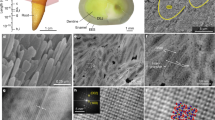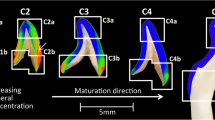Summary
An original method for fractionating and preparing isolated crystals of homogeneous size was developed. It was demonstrated that enamel apatite crystals are at least 100 µm long. The flexibility of the very long crystallites was demonstrated. Crystal curvatures, accounting for the irregular course of the prisms through the enamel thickness, were visualized and measured. It was shown that in the deep forming enamel layer, lateral branches may grow out of the crystals and crystal fusing often occurs, inducing the crystallites to assume pyramidal shapes with their wide bases pointing toward the dentino-enamel junction and one or two tops toward Tomes' processes. During the maturation process, the two tops of the still immature crystals also fuse so that the mature crystals acquire a rodlike aspect, with parallel faces and steplike graduations along thec axis, allowing a close contact between the crystals. These results support the hypothesis that the crystallites would be continuous from the dentino-enamel junction to the surface.
Similar content being viewed by others
References
Jensen AT, Möller A (1948) Determination of size and shape of the apatite particules in different dental enamels and in dentine by the X-ray powder method. J Dent Res 27:524
Little K (1955) Electron microscope studies of teeth. J Dent Res 34:778
Little K (1959) Electron microscope studies on human dental enamel. J R Micr Soc 78:58–66
Frank RM, Sognnaes RF, Kern R (1960) Calcification of dental tissues with special reference to enamel ultrastructure. In: Sognnaes RS (ed) Calcification in biological systems. American Association for the Advancement of Science, Washington DC, pp 163–202
Rönnholm E (1962) The amelogenesis of human teeth as revealed by electron microscopy. II: the development of the enamel crystallites. J Ultrastruct Res 6:249–303
Nylen MU (1964) Electron microscope and allied biophysical approaches to the study of enamel mineralization. J R Micr Soc 83:135–141
Glas JE, Nylen MU (1965) A correlated electron microscopic and microradiographic study of human enamel. Arch Oral Biol 10:893–909
Frazier PD (1968) Adult human enamel: an electron microscopic study of crystallite size and morphology. J Ultrastruct Res 22:1–11
Towe KM, Hamilton GM (1968) Ultramicrotome induced deformation artifacts in densely calcified material. J Ultrastruct Res 22:274–281
Boyde A (1978) Cutting teeth in the SEM. Scanning 1:157–165
Arends J, Jongebloed WL (1978) Crystallites dimensions of enamel. J Biol Buccale 6:161–171
Daculsi G, Kerebel B, Verbaere A (1978) Méthode de mesure des cristaux d'apatite de la dentine humaine en microscopie électronique à transmission de haute résolution. CR Acad Sciences Paris 286:1439–1442
Daculsi G, Kerebel B (1978) High resolution electron microscope study of human enamel crystallites: size, shape and growth. J Ultrastruct Res 65:163–172
Kerebel B, Daculsi G, Kerebel LM (1979) Ultrastructural studies of enamel crystallite. J Dent Res 58 (special issue B):844–850
Nylen MU, Eanes ED, Omnell KA (1963) Crystal growth in rat enamel. J Cell Biol 18:109–123
Selvig KA, Halse A (1972) Crystal growth in rat incisor enamel. The Anat Res 173:453–468
Warshawsky H, Nancy A (1982) Stereo electron microscopy of enamel crystallite. J Dent Res 61:1504–1514
Helmcke JG (1967) Ultrastructure of enamel. In: Miles AEW (ed) Structural and organization of teeth. Vol. II. Academic Press, New York
Leblond CP, Warshawsky H (1979) Dynamics of enamel formation in the rat incisor tooth. J Dent Res 58 (special issue B):950–975
Vogel SC, Weiss MP, Frank RM (1981) High resolution electron microscopic technique applied to the detection of distortions in apatite crystallites during amelogenesis. J Biol Buccale 9:183–191
Hammarlund-Essler E (1971) Trans Royal School of Dentistry, Stockholm and Umea. 4:15–25
Nylen MU (1979) Matrix-mineral relationships. A morphologist's viewpoint. J Dent Res 58 (special issue B):992–926
Meckel AH, Griebstein WJ, Neal RJ (1965) Ultrastructure of fully calcified human dental enamel. In: Stack MV and Fearnhead RW (eds) Tooth enamel, its composition, properties and fundamental structure. John Wright, Bristol, pp. 160–162
Menanteau J, Mitre D, Daculsi G (1984) Aqueous density fractionation of mineralizing tissues: an efficient method applied to the preparation of enamel fractions suitable for crystal and protein studies. Calcif Tiss Int, in press
Author information
Authors and Affiliations
Rights and permissions
About this article
Cite this article
Daculsi, G., Menanteau, J., Kerebel, L.M. et al. Length and shape of enamel crystals. Calcif Tissue Int 36, 550–555 (1984). https://doi.org/10.1007/BF02405364
Issue Date:
DOI: https://doi.org/10.1007/BF02405364




